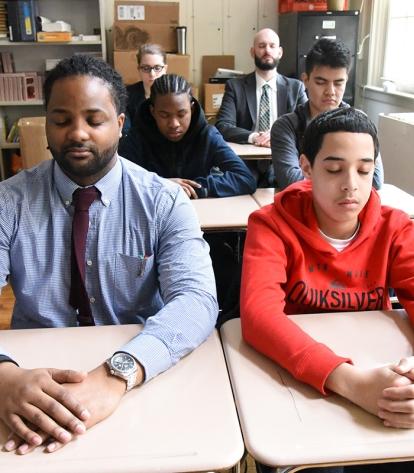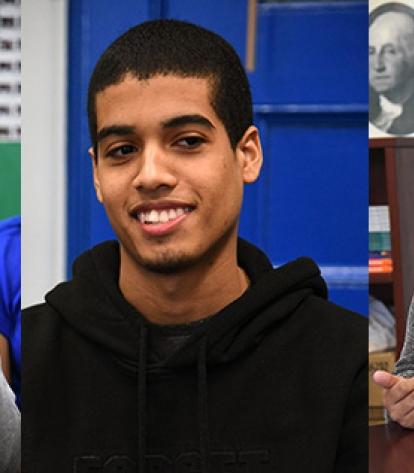At 9:48 in the morning, Adrian Brooks rang a bell and students in his 9th-grade literature class closed their eyes, folded their hands and silently meditated alongside their teacher.
For 18 minutes, the room was perfectly still, as students in Brooks’ class and throughout the Bronx HS for Law and Community Service soundlessly repeated their personal mantras or just rested.
“I was always really tired,” said Ava, a senior who initially questioned the value of meditation. But “having the time to meditate brings me back to myself and gives me time to relax.”
Brooks, the school’s chapter leader, says “the positive impact the Quiet Time program has had on students over time is undeniable.” He attributes improved self-confidence, positive behavioral growth, gains in academic performance and better peer relationships to the two-year-old program’s twice-daily meditations.
Hyehwa Civetta, a special education math instructor who is also a yoga teacher, recalled that the school had received a D on its Progress Report and was on the brink of closing in 2010, when she first suggested meditation to give students a life tool to help cope with stress. “It was a really tough environment for teachers and students,” she said.
Fortuitously, Civetta received an email from the David Lynch Foundation, which teaches Transcendental Meditation for free at high-needs schools. Bronx HS for Law and Community Service qualified: More than 87 percent of the students live below the poverty line, 27 percent have disabilities and 11 percent are English language learners.
Educators and Principal Michael Barakat discussed the Quiet Time program and then applied for the Progressive Redesign Opportunity Schools for Excellence (PROSE) program to change their schedule to accommodate meditation. They agreed to cut the lunch period from 55 to 30 minutes and to shave a few minutes from the passing periods between each class.
“If every student nationwide had access to this program, we’d see a lot less stress, violence and bullying and more attentiveness in class,” said Barakat. “It’s not just for high-needs students — privileged students have stressors, too.”
Guidance counselor Yanirys Sosa was not initially a fan of the idea, but after going through the training, she said, “it felt like a miracle. I got so much energy.” She wasn’t alone.
After the program’s first year, Civetta noticed students weren’t “falling asleep in class anymore.” Those who are tired may end up drowsing off during their meditation, but it leaves them recharged afterward, she said.
English teacher Lola Osoria said her job became easier after the program was introduced. “I used to spend more time calming down students. Now I find their ability to think is deeper than I’ve ever seen.”
Pablo, a sophomore JROTC student who is serious about both school and sports, said meditation has improved his ability to concentrate. “When I’m able to meditate, I feel so much weight come off me and I can focus on the game and school; when I don’t meditate, I can’t focus as well,” he said.
Irvin, a senior taking multiple AP courses, found that stress was taking its toll. “In my sophomore year, my blood pressure was so high that the doctor wanted to give me medication. I said no,” he said. After taking part in the school’s meditation program, he says his blood pressure has returned to normal.
Sosa, the guidance counselor, believes the program will have lifelong benefits for the students. Meditation, she said, is “a gift that students will have forever, that they will use whenever they see fit.”

